Mass and Agitation Art - Massovoe i Agitatzionnoe Iskusstvo - Массовое и Агитационное Искусство
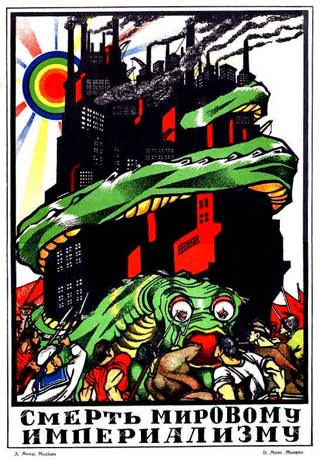
"Death to World Imperialism". D.Moor. 1919.
Russian artists have waited for the Revolution, some with hope, others with fear. The Russian art has always been known to feel the pulse of the time, avidly searching for truth and justice. And when the October Revolution of 1917 has taken place, the art continued dreaming about the new world and the new art, it's mission to serve the people. Today we know what has happened later, when Bolsheviks have used the artists, and ended the game in their own manner. But at the time, the artists had no way of knowing this. Many of them had believed the Bolsheviks. And the constellation of brilliant names is the best evidence.
It was a time of great shocking declarations, deep quests, public manifestations, meetings, and debates. Art exfoliated to many different movements; Futurism appeared, Cubism, Cubofuturism, Rayonism, Constructivism, Non-objectivism. All were enraptured by the novelty of their way. Russian artists had watched closely the achievements of Italian Futurism and others European artists, but they had expressed their own sensations in original ways and national traditions.
A common longing to work for all, for Russia, has drawn together the artists of many movements like Kustodiev, Chekhonin, Petrov-Vodkin, Lebedev, Konenkov, Mukhina, Chagall, Tatlin, Malevich. Artists of the old and new movements were ready to smash the Old, strike for the imagination, disclaim all on their way: the moss-grown academism and the genuine classics. However, amidst the kaleidoscope of innovations, authentic talents ripened.
In the spring of 1918 V.Lenin has proposed his "Plane of Monumental Propaganda": to perpetuate the memory of the Russian and European Great Revolutionists, 66 monuments were erected in the squares and streets of Petrograd and Moscow. The time was difficult, there wasn't enough bread in the Republic, not to mention bronze, marble, granite. The artists had to make do with concrete or even cast. Not only material was in shortage, sometimes projects too had short deadlines, and in order to create a monument more time was needed, emotions were not enough. The monuments were opened solemnly, but almost nothing created in the first post-revolutionary years was preserved.
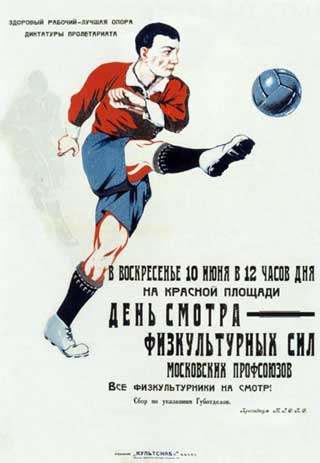
"A day of review of Moscow Athletic Forces
at the Red Square". Unknown artist. 1928.
The artists worked with enthusiasm even on that, which was doomed to short life: placards and festivity designs were made not only passionately, but carefully and with unexceptionable professionalism. They sensed the complicity in history: Russia, who has been considered in Europe a retarded land, has suddenly advanced to the center of attention of the entire world. Hungry artists, searching for the secrets of harmony in unheated studios, unhesitatingly took to the tasks, unprecedented in Russia: festivity and street performance design. Decorate the already splendid architecture of Petrograd, create festivity show and transform it harmoniously with the old city, this task has had no analogies.
Especially grandiose was the celebration of The First Anniversary of the Revolution (1918). The best artists decorated the Palace Square, Admiralty, and others squares and streets, particularly magnificently the various bridges were turned out. Petrograd was decorated by Altman, Dobuzhinsky, Kustodiev, Petrov-Vodkin, Shterenberg, Chekhonin, Lebedev; in Moscow worked the brothers Vesnin, Kuprin, S.Gerassimov, Osmiorkin. Festival shows were designed by Lentulov and P.Kuznezov.
The wonderful sketches that were preserved cannot restore the picture. Moscow, where the capital was transferred from Petrograd, and Petrograd itself, the two chief cities of the country, have looked dismal then. Troops on the streets, hunger, barely a lantern lighting the streets, wick lamps which often died out in the cold houses. The nightly duty at the gates (robbers have raged in the towns), occasional shootings. Long lines formed in front of the bread shops before dawn. But the people looked ahead with confidence, that all which was destroyed shall be rebuilt. The workers at the factories worked not for rations, but according to one's conscience, as much as they could. The Red Army needed equipment, the industry needed to be rebuilt. This period was called "War Communism" and the country was a war camp.
So the first annual celebration has become an embodiment of the Revolution: splendid panels of the best artists of the land, garlands of lamps, well-dressed columns, blue projector rays - all of these seemed to be the sudden realization of the future. Festivals, similar to that in the capital, were arranged in the small provincial towns, too. Unfortunately, a large part of the panels and festive posters were lost.
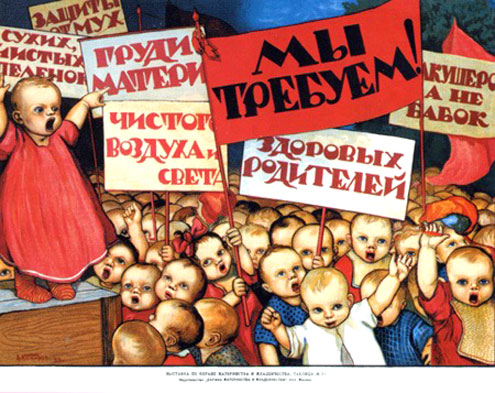
"We demand: mother's breast; clean air and light; healthy parents; medics, not midwives;
dry, clean diapers; protection from flies". Unknown artist. A.L.Komarov. 1923.
Many things were appearing for the first time in history, becoming for the first time the realm of art. Everywhere across the country were moving "agit-trains" and "agit-ships", decorated by agitation paintings and huge decorative posters. In them came together the festive mood, and information, and first lessons in the understanding of art for the people. These trains and ships became a festive overture to meetings with lectors and statesmen. These trains were called "VTZIK on the wheels" (All-Russian Central Executive Committee).
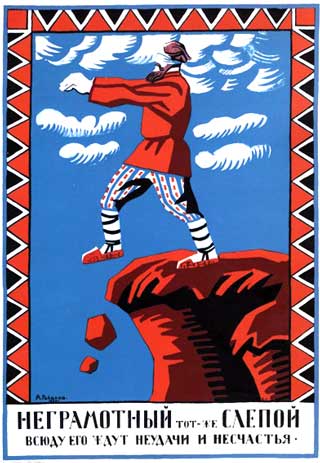
"The illiterate is like a blind man: everywhere
he meets failure and trouble". A.Radakov. 1920.
Poster artists had enormous workload, created a poster in a day, sometimes in a night. The artist Cheremnykh has proposed hanging the posters in empty shop windows, kind of illustrated express-information. And the first poster was met by the public with delight. That has become the celebrated "Okna ROSTA" (Russian Telegraph Agency Windows). At this time, there was a shortage of newspapers, and not nearly all people could read. Therefore, colorful drawings, accompanied by sharp witty chastoushka (two-line or four-line folk verse, usually humorous) were a feast for the eyes as well as avidly absorbed news. "Okna ROSTA" were made by very talented artists, like Deni, Cheremnykh, Mayakovsky in Moscow, Lebedev, Kozlinsky in Petrograd. Mayakovsky alone has created a few hundreds of "Okna ROSTA".
Political poster art united the traditional Russian lubok (folk pictures) with the expressive graphics of the new time. Of course, not everything was successful, but there were posters, which have entered into the history of art (Moor's "Have You Enlisted into the Red Army?", and "Help!", devoted to hunger in Volga district; Lebedev's "Red Army and Navy", or Kozlinsky's "Manifestation"). As splendid as these posters were, many forgot, that the Bolsheviks were to blame for the hungry death of millions of people on the Volga-river and in Ukraine.
Graphic art of that time inclined towards monumentality. New language appeared in the classical kinds of easel graphic and in the book illustrations, as well. But the true break has occurred in the applied art. Post stamps, advertisements, playbills, labels, covers of journals and newspapers - over all lay the reflection of severe elegance, sharp and angular clarity. This was the handwriting of the epoch.
The new symbolism of the country (state emblems, flags, arms etc), the aspiration to fill each image displayed with meaning and sense, has manifested itself in a particularly interesting way in the porcelain art. It wasn't by chance that porcelain painting and creation of china models were taken up by not only ceramics artists. Unique things were created, including slogans on actuality, emblems, inscriptions, either naïve or moralizing. Traditions of the past were sometimes wholly rejected, and at others - united in sharp contrast with the new.
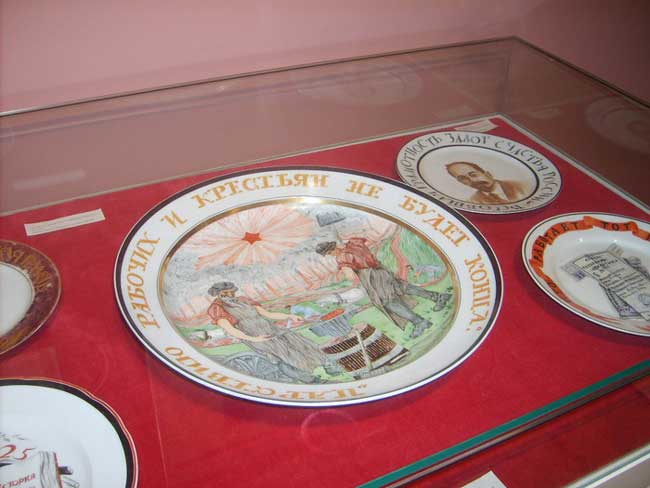
"The Kingdom of workers and farmers will never come to an end". Agit porcelain.
Exhibition of the collection of M.Mironova and A.Menaker.
The Revolution was perceived as cosmic, and it pushed to the path of allegories. The art divided into figurative and nonfigurative, but there was no place in it for indifference. Malevich, employed by the search of abstract harmonies in his paintings, enthusiastically designed new forms for the houses of the future (planits, architechtons), as well as forms for teapots and cups, and set designs and costumes for revolutionary theatre performance "Mystery Buff". Suprematism artists bring a pathos of passionate search to the art, which has influenced the European art on the whole.
This was a complicated time and a complicated art, which is now being appraised anew.
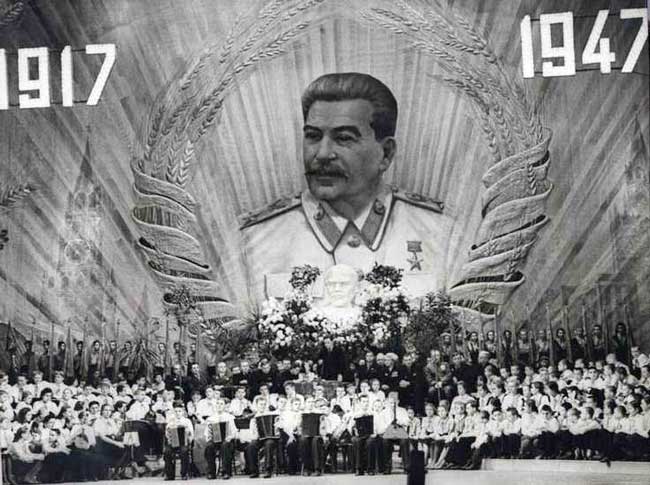
The Bolshoi Theatre decorated for celebration of the 30th Anniversary of the Revolution.
